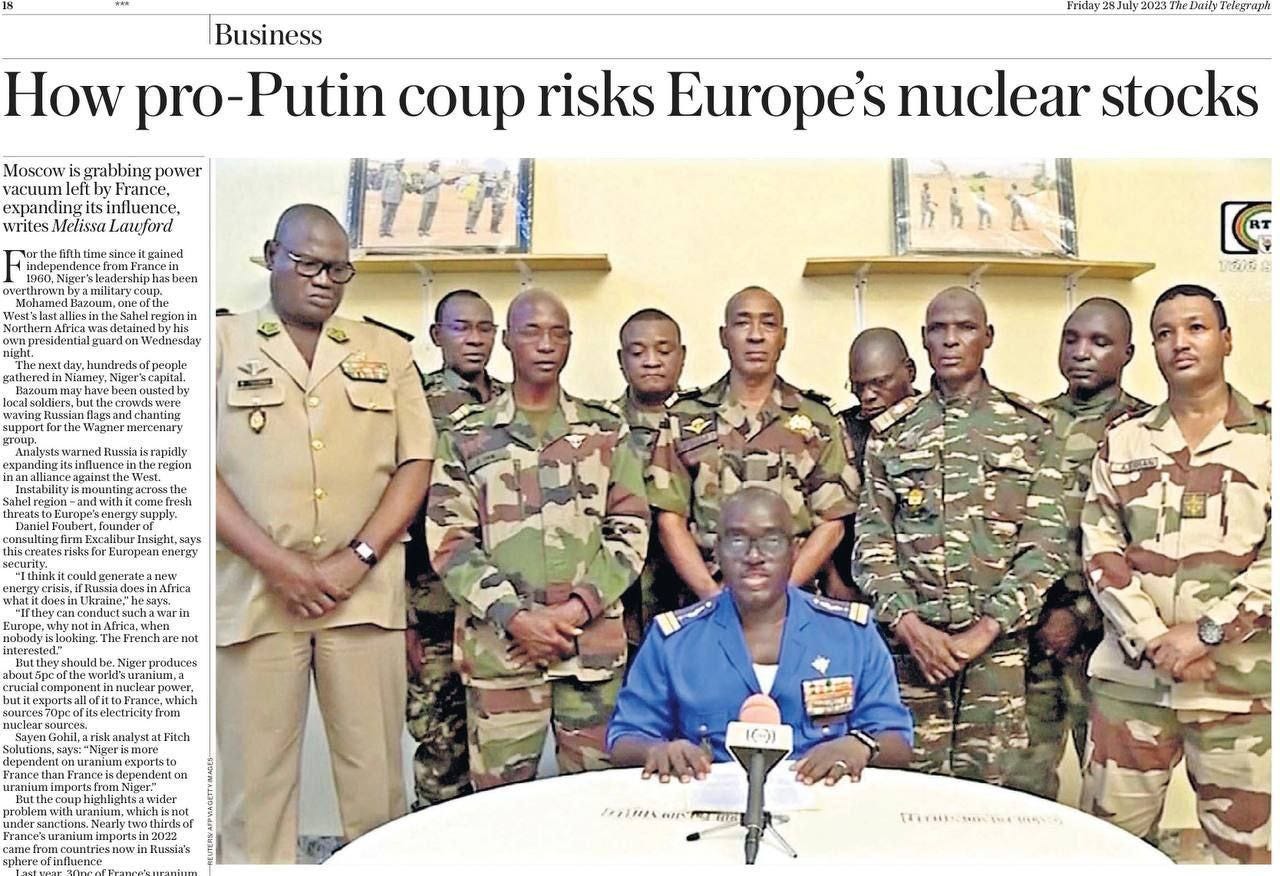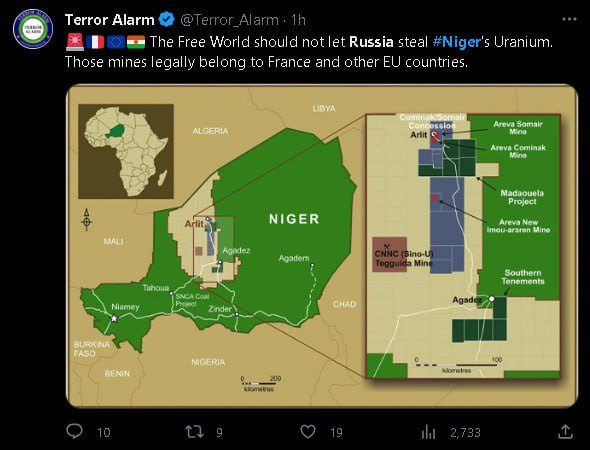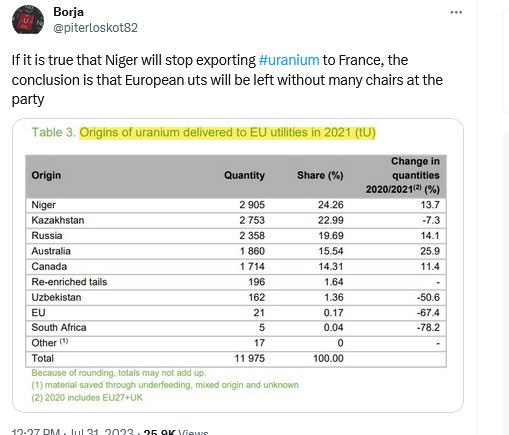Thursday, 31 August 2023
Escaping Attrition: Ukraine Rolls the Dice The Zaporizhia Summer Blockbuster
Thursday, 24 August 2023
WHY RUSSIA IS DECIMATING THE UKRAINE COUNTER OFFENSIVE
Friday, 18 August 2023
Creating and Independent World
Saturday, 12 August 2023
NATO Training Leaves Ukrainian Troops ‘Underprepared’ for War
Yves here. More and more Ukraine-supporting Western outlets are making admissions against interest as far as how the war is going. Consider the twofer in the headline: that Ukraine forces are by implication taking a drubbing from the Russians, and the once-implied-to-be-superior NATO training might be a big reason why.
This framing is a very big shift from repeated claims by US, NATO, and EU officials, as well as many commentators. Russia was running out of missiles. Russian troops had poor morale. Russian forces were badly led. The Russian military was hopelessly corrupt.
This sort of thing has finally started to die down as the much ballyhooed Ukraine counteroffensive has proven to be not just an embarrassing failure, but also a disaster. Independent Western experts like Douglas Macgregor (who recall has excellent contacts) suggest that Ukraine deaths in this campaign are approaching 40,000. To give a sense of significance, compare that to the 60,000 men specifically trained by NATO since March of last year to shore up Ukraine forces. And recall that there are additional, and significant, numbers of wounded men.
On top of that, we had the spectacle of Western equipment such as the vaunted Leopard 2 tanks meeting densely mined Russian “crumple zones” ahead of the Russian fortified lines and not coming out well from the encounter. Western experts also seemed surprised that Russia engaged in remote mining, delivering mines behind the advancing armored vehicles so that if they retreated, more would be lost.
It’s not clear who was behind the decision to try to conserve equipment, but Ukraine has changed tactics to a more manpower-intensive approach of trying to move men close to Russian positions in small groups, usually along tree lines which they hope offers cover, then getting out and moving in on foot.
As Alexander Mercouris in particular has chronicled, the US and NATO are engaged in a blame game with Ukraine. Ukraine is supposedly at fault for being forced to take on a military Mission Impossible, of attacking very well fortified Russian positions with no air support, and worse in a world of ISR where each side can see very well what the other is up to. So the Collective West line is that Ukraine is at fault for abandoning a “combined arms operation” approach like they were supposed to and reverting to something they hoped might work better.
So that is a long-winded way of explaining that this piece is part of the Ukraine effort to point a finger at its sponsors.
Those who have been following the war closely will notice all sorts of omissions and misleading spin. For instance, the piece says those trained by NATO since the war started get 35 days of basic training. As Brian Berletic and Mark Sleboda have pointed out, basic training for US service members is 90 days, and four months for Marines. Berletic made clear that was not remotely adequate for going into combat; he said something to the effect that all you know at that point is how to use a gun and that it takes many months more of working with a unit to reach a basic level of competence.
Scott Ritter has elaborated on that observation by describing how service members need to learn to operate within their unit, then those units need to learn to function effectively as part of a battalion, and then battalions need to learn to train as part of a brigade, and then brigades need to coordinate as part of an army. Ritter has stressed that Ukraine is now burning through its third army and its poor performance is no reflection on the courage of its men, but that you can’t expect forces built on the fly to be effective.
Ritter also stated that training Ukraine troops in so many different countries would lead to additional problems, since each NATO member has its own armed forces and not 100% consistent approaches to operations. That means differences in flavors of training would undermine cohesiveness in action
Berletic and Sleboda (I infer based on personal experience) said many months ago that NATO training is not so hot. Ritter and Macgregor have depicted NATO as in the business of fighting insurgents, as in noting even remotely approaching a peer power. The article confirms that criticism. For instance:
A key concern about the Western training is that the instructors have never fought a war of this kind, or against an enemy like Russia. For years, Western armies and their defence industries have focused on fighting insurgencies in the Middle East.
Even though this piece may seem fairly tame compared to what attentive war-watchers have seen elsewhere, the fact that it goes as far as it does is yet another proof that the West can no longer pretend that Project Ukraine is going well. But you see here nary an admission of how much our arrogance has cost in terms of Ukraine lives and loss of limb.
America’s Cruel War Policy in Ukraine
In the early days, the war in Ukraine had not escalated into the dangerous NATO-Russia nightmare that it is today.
The massive amounts of death and destruction was not yet imagined. Though "the news keeps repeating that Putin is targeting civilians," according to a senior analyst at the Defense Intelligence Agency in March 2022, "there is no evidence that Russia is intentionally doing so." The analyst said that "almost all of the long-range strikes have been aimed at military targets." A retired Air Force officer, working with a "large military contractor advising the Pentagon" added that "the Russian military has actually been showing restraint in its long-range attacks." These sources told Newsweek that Russia was not bombing indiscriminately and that the US dropped more missiles on the first day in Iraq in 2003 than Russia dropped in the first 24 days in Ukraine. Observing the US bombing of Iraq, including the use of depleted uranium and white phosphorous, "British officers were appalled by the lack of concern for civilian casualties." Instead, "The vast majority of [Russian] airstrikes are over the battlefield, with Russian aircraft providing “close air support” to ground forces. The remainder – less than 20 percent, according to U.S. experts – has been aimed at military airfields, barracks and supporting depots." The DIA analyst concluded that "that’s what the facts show. This suggests to me, at least, that Putin is not intentionally attacking civilians."
UNITED STATES PLAN B

“Plan A” is commonly used to denote a current strategy; “Plan B” is commonly used to denote a backup or alternative strategy in case Plan A does not work.
Plan A
For the United States (US), Plan A has been a form of imperialism ever since the Spanish-American War. At that time there was an Anti-Imperialist League in the US (1898), but it was not successful. Imperialism was politically correct for many years, but after WWII, both imperialism and colonies became less fashionable. Eventually, the political scientists and authors in journals of international relations began using the word “hegemony” as a replacement. More general references to US Plan A used the terms “liberal democracy” and “ international rules-based order.” Critics often used the term “American Empire” to annoy the Establishment. One goal of Plan A in recent years has been regime change in Russia to bring about a government similar to the one under Yeltsin.
The Ukraine War had a long gestation period as part of the US Plan A, with an “Orange Revolution” in 2004 and alternating regime changes between those leaning toward the US and those leaning toward Russia. The Ukraine government prior to 2014 had chosen a more beneficial economic package from the East (China & Russia) over the offering from the West (US & EU). China wanted access to the vast grain production regions in Ukraine and Russia wanted to continue historic business and trade relations. After the 2014 regime change, Ukraine dropped the agreement with the East and turned to the West. The grain fields were switched from China to US financial interests. Many factories in Ukraine that had been part of the Russian supply chain lost their business and were no longer viable.
Wednesday, 2 August 2023
SITREP 8/1/23: The Hegemon Begins To Unravel
Momentous things are setting into motion geopolitically all over the globe, most notably in Africa. A coup took down the president of Niger, a country of critical importance to France and the NATO bloc. The Atlanticists are extremely worried now:
France is the #1 country in the world for total percentage of nuclear use for energy generation, and #2 in total number of nuclear power plants. I’ve seen figures that Niger supplies upwards of 40% of France’s Uranium, though some have it in the 15-25% range, as well as 25% to the EU itself.
Now, the coup leader Abdourahamane Tchiani has reportedly banned Uranium and gold exports to France, which could devastate their energy industries, though it could be just a tactic for renegotiations:


